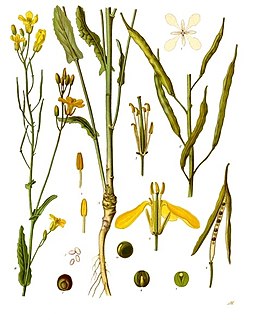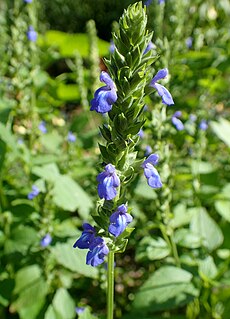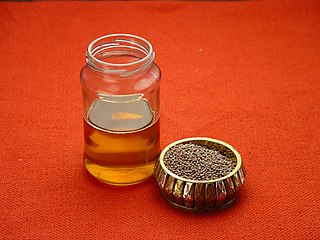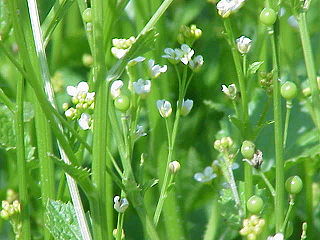Related Research Articles

Biotechnology is a broad area of biology, involving the use of living systems and organisms to develop or make products. Depending on the tools and applications, it often overlaps with related scientific fields. In the late 20th and early 21st centuries, biotechnology has expanded to include new and diverse sciences, such as genomics, recombinant gene techniques, applied immunology, and development of pharmaceutical therapies and diagnostic tests. The term biotechnology was first used by Karl Ereky in 1919, meaning the production of products from raw materials with the aid of living organisms.

Canola oil is a vegetable oil derived from a variety of rapeseed that is low in erucic acid, as opposed to colza oil. There are both edible and industrial forms produced from the seed of any of several cultivars of the plant family Brassicaceae.

Vegetable oils, or vegetable fats, are oils extracted from seeds or from other parts of fruits. Like animal fats, vegetable fats are mixtures of triglycerides. Soybean oil, grape seed oil, and cocoa butter are examples of fats from seeds. Olive oil, palm oil, and rice bran oil are examples of fats from other parts of fruits. In common usage, vegetable oil may refer exclusively to vegetable fats which are liquid at room temperature. Vegetable oils are usually edible; non-edible oils derived mainly from petroleum are termed mineral oils. Often times vegetable oil sold in the U.S. is synonymous with soybean oil.

Genetically modified foods, also known as genetically engineered foods, or bioengineered foods are foods produced from organisms that have had changes introduced into their DNA using the methods of genetic engineering. Genetic engineering techniques allow for the introduction of new traits as well as greater control over traits when compared to previous methods, such as selective breeding and mutation breeding.

Rapeseed is a bright-yellow flowering member of the family Brassicaceae, cultivated mainly for its oil-rich seed, which naturally contains appreciable amounts of erucic acid. Canola are a group of rapeseed cultivars which were bred to have very low levels of erucic acid and are especially prized for use for human and animal food. Rapeseed is the third-largest source of vegetable oil and second-largest source of protein meal in the world.

Coconut oil is an edible oil derived from the wick, meat, and milk of the coconut palm fruit. Coconut oil is a white solid fat, melting at warmer room temperatures of around 25° C, in warmer climates during the summer months it is a clear thin liquid oil. Unrefined varieties have a distinct coconut aroma. It is used as a food oil, and in industrial applications for cosmetics and detergent production. Due to its high levels of saturated fat, numerous health authorities recommend limiting its consumption as a food.
Erucic acid is a monounsaturated omega-9 fatty acid, denoted 22:1ω9. It has the chemical formula CH3(CH2)7CH=CH(CH2)11COOH. It is prevalent in wallflower seed and other plants in the family Brassicaceae, with a reported content of 20 to 54% in high erucic acid rapeseed oil and 42% in mustard oil. Erucic acid is also known as cis-13-docosenoic acid and the trans isomer is known as brassidic acid.

Hemp oil is oil obtained by pressing hemp seeds. Cold pressed, unrefined hemp oil is dark to clear light green in color, with a nutty flavor. The darker the color, the grassier the flavour. It should not be confused with hash oil, a tetrahydrocannabinol-containing oil made from the Cannabis flower.

Salvia hispanica, commonly known as chia, is a species of flowering plant in the mint family, Lamiaceae, native to central and southern Mexico and Guatemala. It is considered a pseudocereal, cultivated for its edible, hydrophilic chia seed, grown and commonly used as food in several countries of western South America, western Mexico, and the southwestern United States.

Mustard oil is an essential oil resulting from grinding the seeds, mixing them with water, and extracting the resulting volatile oil by distillation.

Camelina sativa is a flowering plant in the family Brassicaceae and is usually known in English as camelina, gold-of-pleasure, or false flax, also occasionally wild flax, linseed dodder, German sesame, and Siberian oilseed. It is native to Europe and to Central Asian areas. This plant is cultivated as oilseed crop mainly in Europe and in North America.

Sunflower oil is the non-volatile oil pressed from the seeds of sunflower. Sunflower oil is commonly used in food as a frying oil, and in cosmetic formulations as an emollient.
Omega-9 fatty acids are a family of unsaturated fatty acids which have in common a final carbon–carbon double bond in the omega−9 position; that is, the ninth bond from the methyl end of the fatty acid.

Crambe abyssinica is an annual oilseed crop of the family Brassicaceae. It is mainly cultivated due to the high levels of erucic acid that are contained in its seeds. The crambe oil is used for industrial purposes and its side products can be partly used as animal feed.
Camelina oil or False flax oil is a pressed seed oil, derived from the Camelina sativa or false flax, also called gold of pleasure. False flax has long been grown in Europe, and its oil used as a lamp oil until the 18th century. In recent times, it has been explored for use in cosmetic and skin care products. It has a high content of omega-3 and is used as a food supplement by some cultures. In the United States the Food and Drug Administration has not rated the oil for human consumption yet. False flax belongs to the Brassicaceae family, which also contains many other seed oil plants, such as rapeseed. Typically it contains 1–3% erucic acid but several Camelina Sativa varieties with erucic acid content of less than 1% have been introduced.
Meadowfoam seed oil is a seed oil, extracted from the seeds of Limnanthes alba (meadowfoam). The seeds contain 20-30% oil. Meadowfoam seed oil is extraordinarily stable, primarily because it contains over 98% long chain fatty acids. Meadowfoam oil is most similar to rapeseed oil, with which it competes directly for the high-volume industrial oilseed applications. Meadowfoam oil is widely used in cosmetic and hair-care applications due to its stability, emolliency and smooth, soft skin feel. The oil in its unpurified form is not suitable for human consumption, primarily because of its erucic acid content.
Oleochemistry is the study of vegetable oils and animal oils and fats, and oleochemicals derived from these fats and oils. The resulting product can be called oleochemicals (from Latin: oleum “olive oil”). The major product of this industry is soap, approximately 8.9×106 tons of which were produced in 1990. Other major oleochemicals include fatty acids, fatty acid methyl esters, fatty alcohols and fatty amines. Glycerol is a side product of all of these processes. Intermediate chemical substances produced from these basic oleochemical substances include alcohol ethoxylates, alcohol sulfates, alcohol ether sulfates, quaternary ammonium salts, monoacylglycerols (MAG), diacylglycerols (DAG), structured triacylglycerols (TAG), sugar esters, and other oleochemical products.

Brassica carinata is a species of flowering plant in the Brassicaceae family. It is referred to by the common names Ethiopian rape, Ethiopian mustard. It is believed to be a hybrid between Brassica nigra and Brassica oleracea.

Sinapine is an alkaloidal amine found in some seeds, particularly oil seeds of plants in the family Brassicaceae. It is the choline ester of sinapic acid.
References
- ↑ Mascia, P.N.; Scheffran, J.; Widholm, J.M. (2010). Plant Biotechnology for Sustainable Production of Energy and co-products. Biotechnology in Agriculture and Forestry. Springer Berlin Heidelberg. p. 231. ISBN 978-3-642-13440-1 . Retrieved 18 May 2021.
- ↑ "Crambe". Australian Farm Diversification Information Service. September 2002. Archived from the original on 6 September 2006. Retrieved 21 October 2006.CS1 maint: discouraged parameter (link)
- ↑ Economic Research Service (September 1996). "Crambe, Industrial Rapeseed, and Tung Provide Valuable Oils" (PDF). Industrial Uses. United States Department of Agriculture. pp. 17–23. Archived from the original (PDF) on 10 October 2006. Retrieved 21 October 2006.CS1 maint: discouraged parameter (link)